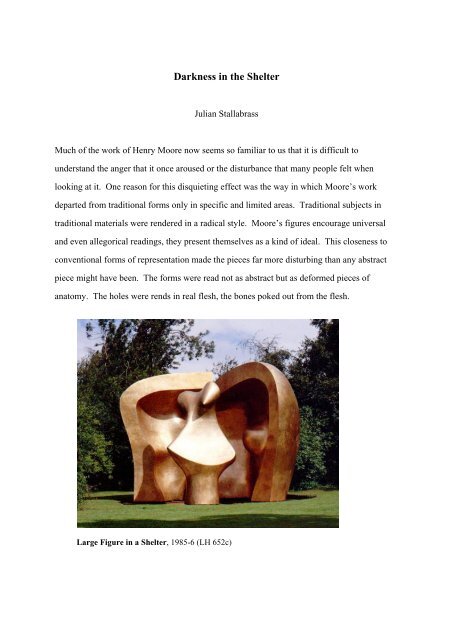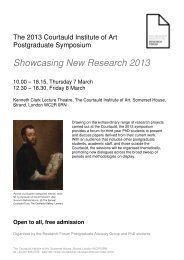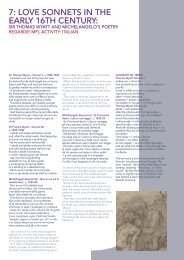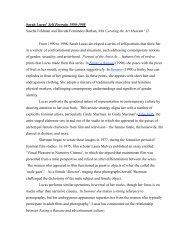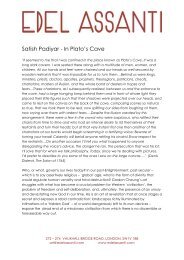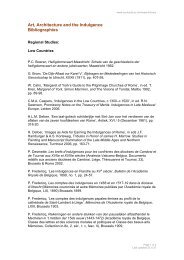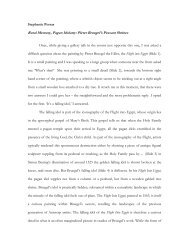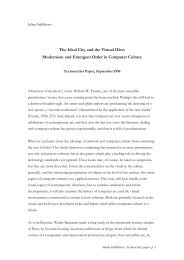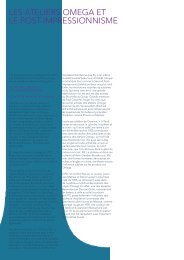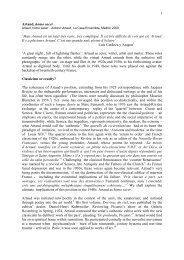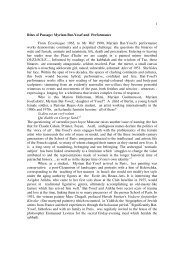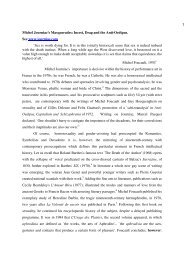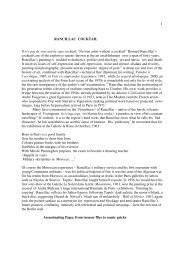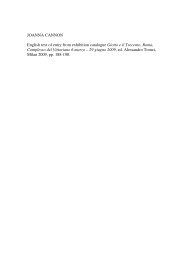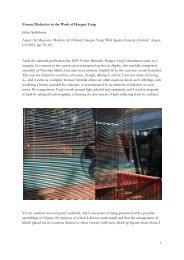Iluna gordelekuan/ Oscuridad en el refugio - The Courtauld Institute ...
Iluna gordelekuan/ Oscuridad en el refugio - The Courtauld Institute ...
Iluna gordelekuan/ Oscuridad en el refugio - The Courtauld Institute ...
Create successful ePaper yourself
Turn your PDF publications into a flip-book with our unique Google optimized e-Paper software.
Darkness in the Sh<strong>el</strong>ter<br />
Julian Stallabrass<br />
Much of the work of H<strong>en</strong>ry Moore now seems so familiar to us that it is difficult to<br />
understand the anger that it once aroused or the disturbance that many people f<strong>el</strong>t wh<strong>en</strong><br />
looking at it. One reason for this disquieting effect was the way in which Moore’s work<br />
departed from traditional forms only in specific and limited areas. Traditional subjects in<br />
traditional materials were r<strong>en</strong>dered in a radical style. Moore’s figures <strong>en</strong>courage universal<br />
and ev<strong>en</strong> allegorical readings, they pres<strong>en</strong>t thems<strong>el</strong>ves as a kind of ideal. This clos<strong>en</strong>ess to<br />
conv<strong>en</strong>tional forms of repres<strong>en</strong>tation made the pieces far more disturbing than any abstract<br />
piece might have be<strong>en</strong>. <strong>The</strong> forms were read not as abstract but as deformed pieces of<br />
anatomy. <strong>The</strong> holes were r<strong>en</strong>ds in real flesh, the bones poked out from the flesh.<br />
Large Figure in a Sh<strong>el</strong>ter, 1985-6 (LH 652c)
<strong>The</strong> sequ<strong>en</strong>ce of works that bear a r<strong>el</strong>ation to Large Figure in a Sh<strong>el</strong>ter, 1985-6 (LH<br />
652c), and which make up this exhibition were mostly produced during the war and in the<br />
years soon after. Many of the H<strong>el</strong>met Heads were produced in 1950. This group of works --<br />
heads, sh<strong>el</strong>terers and the associated prints -- in its<strong>el</strong>f forms an undercurr<strong>en</strong>t to Moore’s work<br />
in g<strong>en</strong>eral: there is a deeply disquieting aspect to them which can be r<strong>el</strong>ated to the ev<strong>en</strong>ts of<br />
the war, and which runs counter to the comfortable and cosy ‘humanist’ view of his work<br />
oft<strong>en</strong> prevails. It is significant that for Moore the origin of the H<strong>el</strong>met Heads was his<br />
abortive b<strong>en</strong>efit project, the lithograph Spanish Prisoner, c. 1939 (CGM 3), just as the<br />
atrocities of the war had their preview on Spanish soil.<br />
<strong>The</strong> H<strong>el</strong>met Heads and many of the associated pieces do not fit in comfortably with the<br />
rest of Moore’s work. <strong>The</strong>y retain a masculine character despite the foetal and mother and<br />
child associations that are oft<strong>en</strong> made. 1<br />
<strong>The</strong>y make specific refer<strong>en</strong>ces to some of the<br />
concerns of Fr<strong>en</strong>ch thought, if not directly to Surrealism. <strong>The</strong>y have a very definite r<strong>el</strong>ation<br />
to the war. This has made their assimilation into the Moore canon difficult, for so much of<br />
his work seems to be concerned with the feminine, with eternal human values, and to evade<br />
any specific categorization or debate.<br />
Our comfortable view of the works of Moore is a comparativ<strong>el</strong>y rec<strong>en</strong>t ph<strong>en</strong>om<strong>en</strong>on. In the<br />
post-war period his work was se<strong>en</strong> at least with a large measure of unease and at the extreme<br />
with disgust and repugnance. This essay will look at the response to Moore’s sculpture in the<br />
years following the war and before it was buried in official approbation for the artist. This<br />
resistance to the work has oft<strong>en</strong> be<strong>en</strong> pres<strong>en</strong>ted as simply a conservative r<strong>el</strong>uctance to accept<br />
formal innovation. Many of those who admired Moore’s skill and formal inv<strong>en</strong>tiv<strong>en</strong>ess,<br />
neverth<strong>el</strong>ess found the works in some way rep<strong>el</strong>l<strong>en</strong>t. <strong>The</strong>y saw this as a quite separate issue<br />
from that of form. Ev<strong>en</strong> Moore’s greatest advocates f<strong>el</strong>t the need to account for the<br />
disturbing nature of his work. <strong>The</strong> problem was oft<strong>en</strong> f<strong>el</strong>t to be the pres<strong>en</strong>ce of something<br />
inhuman within it. K<strong>en</strong>neth Clark wrote of one of Moore’s earliest metal (lead) figures, a<br />
Reclining Figure, 1931 (LH 101), that although it made many descriptive refer<strong>en</strong>ces to the<br />
human body, it was inhuman and ‘more like some terrifying insect’, a ‘monstrous insect
woman’. 2<br />
Philip H<strong>en</strong>dy described some of Moore’s creations in similar terms as having a<br />
‘monstrous anatomy’. 3<br />
<strong>The</strong>re was a widespread assumption that these works in some way<br />
reduced humanity to a lower form of life, immobilized it and ev<strong>en</strong> brought it to a death-like<br />
state. 4 George Digby set up a basic opposition betwe<strong>en</strong> the ideals of the modern world, which<br />
prize individuality and int<strong>el</strong>lect, and the ‘massive and summary’ r<strong>en</strong>dering of figures by<br />
Moore with their limbs ‘stiff<strong>en</strong>ed and distorted’, their heads like stumps. Articulation and<br />
movem<strong>en</strong>t in these figures seemed impossible, he claimed. <strong>The</strong> work appeared primitive, and<br />
the reading of these heads was clearly se<strong>en</strong> as a b<strong>el</strong>ittling of the int<strong>el</strong>lect. <strong>The</strong> distortions of<br />
the body were so extreme that Moore had created ‘atavistic sub-human’ beings which are like<br />
‘great petrified fossils’: ‘<strong>The</strong> emphasis is not only on the static, but ev<strong>en</strong>, in these reclining<br />
figures, on the moribund. Limbs disappear into ridges of stone or metal, holes appear where<br />
vital parts once throbbed, oft<strong>en</strong> only a suggestion of anatomy remains amid the haphazard<br />
lineam<strong>en</strong>ts of inorganic matter, around which remote but subtle human suggestions still<br />
hover.’ 5<br />
Digby, however, was a supporter of Moore’s work. He w<strong>en</strong>t on to write that art was<br />
fundam<strong>en</strong>tally concerned with unconscious and non-personal manifestations of the mind. In<br />
common with many critics, he made refer<strong>en</strong>ce to the supposedly Jungian action of these<br />
pieces on the viewer. In the stunted heads there was ‘the motion and the life of the Zombi;<br />
will and consciousness is not theirs, but the driving force of unlimited, untransformed <strong>en</strong>ergy<br />
passes through them.’ Moore’s work expressed a strongly atavistic attitude, for the chief<br />
characteristic of his art was a strongly regressive urge which acted against the rational <strong>en</strong>ds of<br />
society. It is possible that this attitude reflected an unconscious attitude in our culture ‘the<br />
shadow of a new point of view which is rising into consciousness.’ 6<br />
Similarly Nikolaus Pevsner thought that Moore nearly always reduced natural<br />
appearances to conveying a vitality ‘lower’ than that of the animal or human body: his work<br />
was suggestive of ‘lower life, of the blind growth of roots, of vertebrae or ev<strong>en</strong> cartilage, or<br />
of the passive suffering of the pebble gradually eroded by the slow motion of water and<br />
sand.’ Man was never fit to act, limbs were tapered like stumps, heads excessiv<strong>el</strong>y small,<br />
there was a groping towards the <strong>el</strong>em<strong>en</strong>tary and the pre-conscious. 7
This view of Moore’s work was far from uncommon and it was used particularly to<br />
explain the effect of the works r<strong>el</strong>ated to the H<strong>el</strong>met Heads, most notably the wartime<br />
drawings that Moore made of Londoners sh<strong>el</strong>tering from the Blitz in underground railway<br />
stations. Digby r<strong>el</strong>ated these pieces to dreams in which the subject desc<strong>en</strong>ded into a quarry or<br />
cavern where the rock seemed strang<strong>el</strong>y alive and which, he said, was r<strong>el</strong>ated to the<br />
regressive search for life value in the depths of the unconscious. Likewise the motif of<br />
<strong>en</strong>coiling and <strong>en</strong>twining in the blankets of the sh<strong>el</strong>ter figures was a symbol of the<br />
unconscious attracting <strong>el</strong>em<strong>en</strong>ts of the personality to its<strong>el</strong>f and was ‘part of the g<strong>en</strong>eral<br />
attitude of facing back to the racial depths. It is an invitation to sleep the sleep of ages in the<br />
undiffer<strong>en</strong>tiated unconscious.’ 8<br />
H<strong>el</strong>met Head, 1940 (LH 212)<br />
In much of the writing about Moore there is an association betwe<strong>en</strong> the unconscious<br />
and the primeval, and betwe<strong>en</strong> the dev<strong>el</strong>opm<strong>en</strong>t of the race and the dev<strong>el</strong>opm<strong>en</strong>t of the<br />
individual: 9<br />
the sleeping figures regress not only into the depths of their own psyches but into<br />
the depths of the history of the species. David Sylvester, one of the major writers on Moore<br />
in this period, wrote of the mystery of these protean forms which lead us back to a primeval<br />
world where the differ<strong>en</strong>ces betwe<strong>en</strong> classes of objects no longer apply, a world of forms<br />
which might have existed ‘on some vast seashore before the coming of man’. 10<br />
Pevsner<br />
thought that although Moore was in sympathy with his subject in the sh<strong>el</strong>ter drawings, they<br />
were still ‘sub-human’ and ‘newt-like’ figures which were afforded no beauty or pride. 11<br />
<strong>The</strong>
forms of the H<strong>el</strong>met Heads were also read as sub-human: Digby wrote of the 1940 H<strong>el</strong>met<br />
Head (LH 212) as being ‘a curious structure which contains inside its<strong>el</strong>f an indep<strong>en</strong>d<strong>en</strong>t <strong>el</strong>flike<br />
figure, a sort of animacule’. 12<br />
<strong>The</strong> primitivism of the tw<strong>en</strong>ties and thirties had be<strong>en</strong> tak<strong>en</strong><br />
(perhaps under the great pressure of ev<strong>en</strong>ts in the forties) to a stage where categories no<br />
longer existed, where minds no longer functioned and where species had bar<strong>el</strong>y emerged<br />
from the primal soup.<br />
Beyond the idea that the Sh<strong>el</strong>ter figures are sub-human and incapable of action, there is<br />
a further reading of them as in some s<strong>en</strong>se already dead. Sylvester wrote that in the drawing<br />
Shadowy Sh<strong>el</strong>ter, 1940 (HMF 1735) we can ‘see bones glimmering through flesh become<br />
transpar<strong>en</strong>t’, and he r<strong>el</strong>ates this to a movem<strong>en</strong>t in Moore from animate to inanimate and back,<br />
reflecting natural cycles. 13<br />
In the light of the war these figures were se<strong>en</strong> to have a more specific refer<strong>en</strong>ce than<br />
being mer<strong>el</strong>y an abstract comm<strong>en</strong>t about mortality. Frederick Wight described them as<br />
having ‘a curious air of being aroused to a differ<strong>en</strong>t sort of life than ours, that is devoid of<br />
incid<strong>en</strong>t. <strong>The</strong>ir clothes . . . are cerem<strong>en</strong>ts. <strong>The</strong>y have the Lazarus look; they are brought like<br />
Alcestis from the grave. Moore is dealing here with mortality and immortality’ 14 . But he<br />
continued: ‘Now there is a stage in the wastage beyond death of which we carefully avoid<br />
the sight. <strong>The</strong> harder tissues, t<strong>en</strong>dons and bones are all that is left; the soft tissues are gone.<br />
<strong>The</strong> body fights a slow rearguard action, such as it did alive in the Büch<strong>en</strong>wald photographs.<br />
This charn<strong>el</strong> house effect haunts the Sh<strong>el</strong>ter Perspective drawing, is striking in the drawings<br />
for sculpture, parched away as the figures are to mere t<strong>en</strong>don and bone . . . Here is a steady<br />
progression toward the boneyard in the most literal s<strong>en</strong>se.’ 15<br />
Again, the association is not<br />
uncommon. Sylvester wrote of the drawings of 1942-6 as containing ‘beings thin and<br />
emaciated, like the inhabitants of B<strong>el</strong>s<strong>en</strong>, with skin drawn tight over protesting bones.’ 16<br />
That<br />
Moore’s fe<strong>el</strong>ing for the horrors of the war did not diminish with time and that he continued to<br />
dev<strong>el</strong>op this dark side of his work, may in part be attributed to his visit to Auschwitz. Moore<br />
served as the chairman of an international jury for a monum<strong>en</strong>t for Auschwitz in 1958; 17<br />
the<br />
H<strong>en</strong>ry Moore Foundation holds a number of photographs of the buildings and ov<strong>en</strong>s tak<strong>en</strong> by<br />
him during this visit. [illustrate]
Of course these disturbing images of the sh<strong>el</strong>terers were, for many people, difficult to<br />
accept as appropriate war images. D<strong>en</strong>nis Rudder comparing them more conv<strong>en</strong>tional images<br />
like the individualized and comforting figures of Edward Ardizzone, found them ‘doomed<br />
and haunted’, restless, uneasy and disturbing. <strong>The</strong>y protest against the fate that buries them<br />
alive and are conscious only of their own pitifulness. Moore’s d<strong>el</strong>icate colouring here<br />
acc<strong>en</strong>tuates ‘the cerem<strong>en</strong>tal atmosphere surrounding bewildered, lost, souls.’ Eric Newton,<br />
who quoted this passage, w<strong>en</strong>t on to say that Moore’s work was so extreme that many people<br />
found it difficult to deal with. 18<br />
Another of Moore’s staunchest supporters, Patrick Heron, accepted the characterization<br />
of much of the sculptor’s work as sub-human and r<strong>el</strong>ated this to the disturbances he thought<br />
typical of the age. <strong>The</strong>re was in Moore’s work, he said, an ‘. . . id<strong>en</strong>tification of animate with<br />
inanimate realities, of the human figure with eroded rock-strata, of Man with primeval<br />
creatures whose facial features and limbs are less articulated, definite, or expressive of<br />
personality than our own. Everyone responds with an unquiet thrill to the typical<br />
streamlined, seal-like almost featur<strong>el</strong>ess heads of a H<strong>en</strong>ry Moore reclining figure or torso. A<br />
hundred disturbing ideas interpose thems<strong>el</strong>ves: Is this seal-head an atom-blasted fri<strong>en</strong>d of<br />
ours? What schizophr<strong>en</strong>ia emanates from the two blind, equal knob-heads of this metal<br />
Standing Figure of 1950 [LH 290]? What universal dilemmas or fears are symbolized in<br />
these neverth<strong>el</strong>ess imm<strong>en</strong>s<strong>el</strong>y noble forms? . . . His sculpture assails us with the grandeur<br />
and magnitude of vast impersonal forces; it possesses, so oft<strong>en</strong>, the blindness of the<br />
inanimate or the g<strong>en</strong>eralized.’ 19<br />
For Heron the fe<strong>el</strong>ings aroused by these pieces were far from<br />
comfortable, and he thought that such a response was wid<strong>el</strong>y f<strong>el</strong>t: they referred not just to<br />
universal dilemmas but to specific contemporary concerns. Edward Sackville-West took up a<br />
similar point in writing of the Reclining Figures as r<strong>el</strong>evant to the crisis of our times, ‘for<br />
these mindless giants suggest a world which has suffered some kind of cataclysm. <strong>The</strong>ir<br />
pres<strong>en</strong>ce invokes the dead planets and the livid, damaged moons which <strong>en</strong>danger the sky<br />
behind a Christ by Tura.’ 20<br />
<strong>The</strong> primeval aspect of these works seemed to be connected with<br />
a cataclysm that had either just passed or was considered immin<strong>en</strong>t.
Unesco Reclining Figure, 1957-8 (LH 416)<br />
John Berger, from a viewpoint highly critical of Moore, asked of the distorted forms of<br />
the Unesco Reclining Figure, 1957-8 (LH 416): ‘<strong>The</strong>y are dead? Not quite. More dead<br />
than alive? Inorganic matter . . . Moore’s subject here is not a woman: it is the inert material<br />
he has in his hands. . . . It is an object striving to become an image: a prophecy of life not yet<br />
manifest.’ 21<br />
For Berger the deathly aspect of Moore’s sculpture was not int<strong>en</strong>tional, but was<br />
rather a result of the artist’s obsession with the nature of his material and his neglect of<br />
meaning.<br />
It is clear that at least in the case of the H<strong>el</strong>met Heads, Moore int<strong>en</strong>ded the effect to be<br />
disturbing and in r<strong>el</strong>ation to H<strong>el</strong>met Head No. 1, 1950 (LH 279) he said as much. He also<br />
spoke of the way that the idea of the interior/exterior form was r<strong>el</strong>ated to his interest in early<br />
armour, a ‘sh<strong>el</strong>l’ for a ‘soft form’. Armour, said Moore, has a ‘weird expression’ and the<br />
H<strong>el</strong>met Heads are meant to emulate this ‘disturbing and strange expression’. 22<br />
For Erich<br />
Neumann H<strong>el</strong>met Head No. 1 is strange, sinister and inhuman, it does what the skull did for<br />
our ancestors being the contemporary symbol of ‘a pur<strong>el</strong>y technological death’ clos<strong>el</strong>y
connected to modern anxieties. Neumann wrote of modern man: ‘It is almost a wishful<br />
fantasy if he wants to be allowed to die peacefully in bed instead of being cut to pieces by<br />
sh<strong>el</strong>l splinters, buried under collapsing houses, roasted alive by atom bombs, or reduced to a<br />
mass of suppuration by radioactive fallout.’ This technological head is utterly ali<strong>en</strong> to us and<br />
inspires horror. 23<br />
<strong>The</strong> forms of the H<strong>el</strong>met are irregular but sharp, as if manufactured, as is<br />
the being inside, whose off<strong>en</strong>sive shape is reminisc<strong>en</strong>t of a push-dagger. <strong>The</strong> v<strong>en</strong>ts at the<br />
back of the h<strong>el</strong>met contribute to the mechanical air of the piece. While the nodules on top of<br />
the H<strong>el</strong>met (and the holes through it) can be read as eyes, they remind one of the similar<br />
features found on German h<strong>el</strong>mets from the war. Will Grohmann thought that in the 1950<br />
H<strong>el</strong>mets the inner figure changes into ‘something more rep<strong>el</strong>l<strong>en</strong>t, technological and warlike’<br />
rather like a stereo-t<strong>el</strong>escope. It is a ‘mythological abstract conception’ in which primeval<br />
and technological aspects are connected. 24<br />
Since Moore’s figures have so much contact with naturalism it was difficult not to read<br />
the deformations in them as acts of viol<strong>en</strong>ce or mutilation. Gordon Onslow-Ford comm<strong>en</strong>ted<br />
on the ‘wound’ across the face and the hole running through the l<strong>en</strong>gth of the body of the<br />
Reclining Figure, 1939 (LH 210), which ‘possesses the sadistic and erotic values expressed<br />
from the unconscious that are to be found in great creations of the past.’ 25<br />
Wight observed the<br />
way Moore op<strong>en</strong>ed up of the cavities of the head: ‘he drills into the pupils of the eyes, makes<br />
a gash for the mouth, and finally op<strong>en</strong>s or slots the skull’. 26<br />
Digby wrote that in many of the reclining figures there was a dismemberm<strong>en</strong>t of limbs,<br />
and pointed out that it was almost always the most highly dev<strong>el</strong>oped human parts which<br />
suffered most. ‘Hands, feet, the vital organs are atrophied, amputated, or pierced, and there is<br />
a characteristic t<strong>en</strong>d<strong>en</strong>cy to reduce the head to a mere cypher.’ 27<br />
For Digby this repres<strong>en</strong>ted<br />
an archetypal theme in Moore’s art. Dismemberm<strong>en</strong>t is in Jungian psychology a symbol of<br />
rebirth and psychological reori<strong>en</strong>tation, and this neatly ties together the aspects of<br />
dismemberm<strong>en</strong>t and nurture. However, Digby f<strong>el</strong>t that the dismembering of the body in<br />
Moore’s art was so extreme that it was possible that it could function as a d<strong>en</strong>ial rather than a<br />
symbol of rebirth. Moore might be exhibiting ‘schizoid’ traits, in the s<strong>en</strong>se of a dissociation<br />
of the emotional and int<strong>el</strong>lectual life. <strong>The</strong>se dissociated <strong>el</strong>em<strong>en</strong>ts show signs of ‘savagery as
w<strong>el</strong>l as much which is ugly, malformed and vicious. . . . It is a mirror for contemporary man<br />
to gaze into [...].’ 28<br />
Mutilation might be a positive feature, but if it is not the mutilated soul of<br />
Moore is no more than a reflection of our own.<br />
<strong>The</strong> argum<strong>en</strong>t about mutilation turns around whether we see the pieces as metal, stone<br />
and wood, or as flesh its<strong>el</strong>f. <strong>The</strong> hardness of Moore’s material, the way that it r<strong>en</strong>ders flesh,<br />
is oft<strong>en</strong> tak<strong>en</strong> to reflect the hardness of Moore’s s<strong>en</strong>sibility. One critic wrote of the figures in<br />
Moore’s drawings playing at being turned into stone, at being statues, for their surface is<br />
harder than the substance of flesh. 29<br />
<strong>The</strong> 1951 Tate Gallery exhibition catalogue associated<br />
Moore’s metaphorical substitution of bones, pebbles and sh<strong>el</strong>ls for parts of the body with his<br />
imagination ‘obsessed with what is hard, strong and stony.’ 30<br />
Bryan Robertson dealt with the issue of the fleshiness of Moore’s work in 1961. Only<br />
rec<strong>en</strong>tly, he claimed, had the artist come to terms with r<strong>en</strong>dering flesh, previously there had<br />
be<strong>en</strong> just bone, rock and fossil, and this somehow fitted in with the retic<strong>en</strong>t, almost cerebral,<br />
‘dispassionate coldness’ of the artist’s nature. Such work is tough, compressed and vital but<br />
lacks warmth, and ev<strong>en</strong> the Sh<strong>el</strong>ter drawings which are the result of strong emotion are<br />
‘fierce, grim studies’ which make no concession to s<strong>en</strong>tim<strong>en</strong>tality or pathos. 31<br />
If we read the<br />
material as stone it is a sign of Moore’s coldness, if we read it as flesh it is a sign of<br />
mutilation.<br />
Wight says that Moore eviscerates the figure carving away all the soft parts and leaving<br />
only hard forms. <strong>The</strong> chest or breast is the feeding ground of the child and from the child’s<br />
point of view it is natural that it should be eat<strong>en</strong> away. 32<br />
While many of the interiors of the<br />
H<strong>el</strong>met Heads appear mechanical or sk<strong>el</strong>etal, Head: Cyclops, 1963 (LH 507), contains a<br />
slug-like form that could hardly be more fleshy. Here is an almost programmatic<br />
combination of hard and soft.<br />
<strong>The</strong> curr<strong>en</strong>t of negative fe<strong>el</strong>ing about Moore’s subjects did not go unopposed. <strong>The</strong>re<br />
was certainly a strong tr<strong>en</strong>d in contemporary criticism towards defusing the fright<strong>en</strong>ing<br />
nature of Moore’s work, and this applied as much to those who attacked it as to those who<br />
praised it. <strong>The</strong> most common av<strong>en</strong>ue of attack, ev<strong>en</strong> from his admirers, was the charge of
eing too suave, too good to be true. <strong>The</strong> pristine quality of his surfaces was associated with<br />
the supposedly uncomplicated nature of the work. Patrick Heron comm<strong>en</strong>ted on the extreme<br />
smoothness of Moore’s surfaces which led to a certain ‘vacancy’. 33<br />
Basil Taylor, Heron’s<br />
oppon<strong>en</strong>t in a debate on Moore staged in the magazine Encounter, also highlighted this<br />
aspect, describing Moore’s ‘suave’ surfaces as being as inexpressive as a fin<strong>el</strong>y turned chair<br />
leg. It is this that makes Moore’s work much favoured by the camera, especially in the detail<br />
which shows the ‘comforting, intriguing caverns’ and beautiful textures without their full<br />
context. 34<br />
Douglas Cooper and Clem<strong>en</strong>t Gre<strong>en</strong>berg had similar complaints, Cooper saying<br />
that Moore’s real trouble was that he was fright<strong>en</strong>ed of being vulgar, Gre<strong>en</strong>berg that his<br />
sculpture was so tasteful that there was no difficulty or surprise about his art, that it was the<br />
work of a ‘sincere academic modern’. 35<br />
Other tactics were used to defuse the force of these works. One solution was signalled<br />
by Philip H<strong>en</strong>dy and was r<strong>el</strong>ated to formalism. H<strong>en</strong>dy called the Reclining Figure in<br />
<strong>el</strong>mwood (1939) ‘a rather fright<strong>en</strong>ing object’, but only if we have not followed the<br />
dev<strong>el</strong>opm<strong>en</strong>ts leading up to it, if we do not see it in terms of the logic of a formal<br />
dev<strong>el</strong>opm<strong>en</strong>t. Similarly the reinforced concrete Reclining Figure, 1933 (LH 134) is ‘a<br />
rep<strong>el</strong>l<strong>en</strong>t figure if one does not succeed in dissociating it from the human form, which has<br />
fall<strong>en</strong> apart to be connected again by <strong>en</strong>trails in stone’. If we do succeed in this, claimed<br />
H<strong>en</strong>dy, it becomes a fascinating formal experim<strong>en</strong>t. 36<br />
We must learn not to be disturbed by<br />
these objects. <strong>The</strong> distortions have no meaning except as the result of a formal dev<strong>el</strong>opm<strong>en</strong>t<br />
which has its own logic indep<strong>en</strong>d<strong>en</strong>t of any iconographic refer<strong>en</strong>ce.<br />
Another solution is the impulse to universalize the art of Moore and so remove or<br />
diminish its more specific refer<strong>en</strong>ces. This process was important for the acceptance of<br />
Moore’s work as an official and monum<strong>en</strong>tal medium. It was, inadvert<strong>en</strong>tly, backed by<br />
Herbert Read in the exhibition 40 000 Years of Modern Art: the argum<strong>en</strong>t of the show (in<br />
which Moore featured) was that there existed an eternal and universal recurr<strong>en</strong>ce of certain<br />
ph<strong>en</strong>om<strong>en</strong>a in art that might be called ‘modern’. Conditions in modern life were h<strong>el</strong>d to have<br />
produced effects se<strong>en</strong> only in primitive epochs; while Read warned that a strict definition of<br />
these ‘archetypal’ conditions was impossible since they were buried in the unconscious, he
described them as ‘a vague s<strong>en</strong>se of insecurity, a cosmic anguish (Angst, as the Exist<strong>en</strong>tialists<br />
call it), fe<strong>el</strong>ings and intuitions that demand expression in abstract or unnaturalistic forms.’<br />
<strong>The</strong>re is nothing inhuman about these forms, rather they are ‘inevitable modes’ in which<br />
certain phases of human experi<strong>en</strong>ce are expressed. 37<br />
To apply this to Moore th<strong>en</strong>, his pieces<br />
might seem inhuman, but this is an illusion caused by the changing historical mom<strong>en</strong>t: they<br />
are in fact as universal as any other kind of true art.<br />
Critics oft<strong>en</strong> wrote of Moore’s work in these universal terms, as a substantiation of the<br />
age, the struggles and suffering of mankind. 38<br />
This was just the kind of reading that was<br />
criticized by John Berger for being too g<strong>en</strong>eral: ‘Moore’s great popularity, can, I think, like<br />
Sutherland’s, be larg<strong>el</strong>y explained by the pres<strong>en</strong>t s<strong>en</strong>tim<strong>en</strong>tal, highbrow fashion for projecting<br />
crises of consci<strong>en</strong>ce and introspection on to the tim<strong>el</strong>ess processes of nature. In some ways it<br />
is a comfort to lose ones<strong>el</strong>f in the aeons, to hide in the rock of ages’. 39<br />
<strong>The</strong>re is a s<strong>en</strong>se here in<br />
which the very exig<strong>en</strong>cies of the post-war period are used to give Moore’s work a more<br />
universal than specific refer<strong>en</strong>ce, and thus defuse them as political or social statem<strong>en</strong>ts.<br />
This highly g<strong>en</strong>eralized reading of Moore’s work in r<strong>el</strong>ation to the eternal human<br />
condition and specifically in r<strong>el</strong>ation to the Heads was exemplified in the essay by Geoffrey<br />
Grigson for the album, Heads, Figures and Ideas (1958). Many states and gestures of ‘man’<br />
are described: in addition, ‘Heads hollowed and filled with space. . . . IDEAS -- the realized<br />
play of the abs<strong>en</strong>t and the pres<strong>en</strong>t’. 40<br />
It is significant that here ev<strong>en</strong> the Heads have tak<strong>en</strong> on a<br />
universalized meaning.<br />
Critics were particularly anxious to d<strong>en</strong>y the H<strong>el</strong>mets any specific reading and to stress<br />
that Moore had arrived at formal solutions that anticipated their creation before the outbreak<br />
of war. For Grohmann the idea that ste<strong>el</strong> h<strong>el</strong>mets and gas masks played a part in Moore’s<br />
dev<strong>el</strong>opm<strong>en</strong>t of the H<strong>el</strong>mets ‘cannot be dismissed out of hand’ but must neverth<strong>el</strong>ess have<br />
be<strong>en</strong> a ‘confirmation of his inner ideas’. 41 Read pointed out that Figures in a Cave, 1936<br />
(HMF 1260), anticipated forms se<strong>en</strong> in the sh<strong>el</strong>ter drawings 42 .<br />
Of course the disturbing aspect of these works could simply be d<strong>en</strong>ied, but in the case<br />
of the Heads this happ<strong>en</strong>ed very rar<strong>el</strong>y. Despite their association with the foetus in the womb
and the child in its mother’s arms, positive readings of the H<strong>el</strong>met Heads in emotional terms<br />
are very uncommon. 43<br />
Despite attempts to explain away the disturbing effect of these works, it was still thought<br />
necessary by many writers to try to explain their meaning. Many of Moore’s critics struggled<br />
with this problem, and some of the more formalist writers saw it as being quite indep<strong>en</strong>d<strong>en</strong>t<br />
of the aesthetic issues as such. So Heron found it much easier to def<strong>en</strong>d the formal qualities<br />
of Moore’s pieces than to explain their poetic and symbolic cont<strong>en</strong>t which he found hard to<br />
define and ev<strong>en</strong> disquieting. He did not think that id<strong>en</strong>tifying the forms with embryos and<br />
thus seeing the works as a retreat from the full consciousness of modern life was a useful<br />
approach. 44<br />
It was g<strong>en</strong>erally considered to be the war that led Moore from the position of being a<br />
marginal artist of the avant-garde to being a famous and in some s<strong>en</strong>se official artist. This<br />
dev<strong>el</strong>opm<strong>en</strong>t was oft<strong>en</strong> attributed to an increase in the human cont<strong>en</strong>t, or the ‘humanism’, of<br />
Moore’s work, as w<strong>el</strong>l as to a more sympathetic response on the part of a public with whom<br />
Moore had shared the experi<strong>en</strong>ces of war. Read wrote that the Sh<strong>el</strong>ter drawings proved the<br />
‘inher<strong>en</strong>t humanism’ of his earlier work. 45<br />
Trewin Copplestone claimed that Moore, like so<br />
many of his contemporaries, was concerned with ‘the humanizing of the <strong>el</strong>em<strong>en</strong>ts of his<br />
material.’ <strong>The</strong> warrior figures, for instance, he saw as a visual protest against the indignity of<br />
force and the blind sacrifice of individual humanity. 46<br />
For some though, notably Pevsner, this move towards humanism was the consequ<strong>en</strong>ce<br />
of a retreat from modernist forms: the Sh<strong>el</strong>ter Sketchbooks and the Madonna and Child,<br />
1943-4 (LH 226) in Northampton were usually cited in evid<strong>en</strong>ce. Pevsner wrote of Moore’s<br />
solitary art which bewildered the public, who could hardly be expected to communicate with<br />
an artist so concerned with ‘dem<strong>en</strong>ted exist<strong>en</strong>ce’ and so appar<strong>en</strong>tly out of sympathy with the<br />
individual man, woman and child. Moore’s work was formally beautiful, but except in the<br />
Northampton Madonna this was not complem<strong>en</strong>ted by human values. 47<br />
This common<br />
argum<strong>en</strong>t led avant-garde critics to try to show that Moore had abandoned humanism since<br />
the war as part of a repudiation of naturalism. Herbert Read thought that Moore’s King and
Que<strong>en</strong> and Family Group figures were a break with wartime ‘humanism’ and an advance into<br />
‘the superhuman realm of myth. . . . <strong>The</strong>y are figures of mystery and fate: they look calmly<br />
into futurity.’ 48<br />
Some of the most string<strong>en</strong>t criticism of Moore in this period was made precis<strong>el</strong>y on this<br />
issue of meaning and refer<strong>en</strong>ce. John Berger argued that the work needing a clearer<br />
refer<strong>en</strong>ce: dignity, str<strong>en</strong>gth and power are just ‘words offered to mysterious gods’. For<br />
Berger Moore’s work is beautiful, but because of its lack of refer<strong>en</strong>ce, it is closer to the object<br />
than the image. 49<br />
In Berger as in Heron and others there was always thought to be a split betwe<strong>en</strong> form<br />
and meaning in the work of Moore. For Read at least, the forms and their meaning were<br />
interdep<strong>en</strong>d<strong>en</strong>t, the forms being physical embodim<strong>en</strong>ts of archetypes, operating by<br />
association in the collective unconscious. 50<br />
Natural forms were clumsy and conting<strong>en</strong>t<br />
realizations of the spiritual ess<strong>en</strong>ce that lay behind all appearances. Art should strip nature of<br />
its ‘casual excres<strong>en</strong>ces’ to reveal the forms that spirit would evolve if not governed by<br />
function. 51<br />
Moore’s process of transformation was always governed by a ‘transc<strong>en</strong>d<strong>en</strong>tal<br />
purpose’ for what was transformed was an ‘imman<strong>en</strong>t spirit’: he combined human fe<strong>el</strong>ing<br />
(animism) with dynamism. 52<br />
For Read it was not Moore’s sculpture that is deformed, it was<br />
ours<strong>el</strong>ves.<br />
Moore hims<strong>el</strong>f gives us clues as to the specific meaning of some pieces associated with<br />
the H<strong>el</strong>met Heads: he wrote that the one eyed figures, such as Contemplative Eye, 1974<br />
(CGM 356), came out of the H<strong>el</strong>met Head idea by chance wh<strong>en</strong> he tore up some drawings: ‘I<br />
surrounded the head fragm<strong>en</strong>ts with frames or window op<strong>en</strong>ings to give them the suggestion<br />
of soldiers observing the <strong>en</strong>emy from concealed positions behind battlem<strong>en</strong>ts.’ 53<br />
A common theme in Moore criticism and one to which the H<strong>el</strong>met Heads bear an odd r<strong>el</strong>ation<br />
is the stress on the idea of the sculpture growing, being a product of forces pressing on it from<br />
within. <strong>The</strong>re is a fe<strong>el</strong>ing of something stirring under the skin of the sculpture. Moore<br />
hims<strong>el</strong>f <strong>en</strong>couraged this interpretation, writing about the force and power that strained from<br />
the inside of a piece: ‘Hardness, projection outwards, gives t<strong>en</strong>sion, force, and vitality.’ 54<br />
He
also thought that the sculpture should make the viewer fe<strong>el</strong> that what he was seeing ‘contains<br />
within its<strong>el</strong>f its own organic <strong>en</strong>ergy thrusting outwards . . . It should always give the<br />
impression, whether carved or mod<strong>el</strong>led, of having grown organically, created by pressure<br />
from within.’ 55<br />
This aspect was oft<strong>en</strong> stressed by writers on Moore. His Reclining Figures always<br />
contained ‘numerous and complex movem<strong>en</strong>ts and combinations of form under the skin of<br />
the carving, as it were.’ 56<br />
Heron it thus: ‘in one’s eye the image sw<strong>el</strong>ls and changes, contracts<br />
and changes, as one steps around the sculpture standing there, before one, in space. 57<br />
In<br />
making a sculpture ever more complex, Moore stretches and distorts but never ruptures the<br />
membrane (the skin of a balloon or ‘<strong>en</strong>v<strong>el</strong>ope’) that surrounds it. Carving determines that<br />
this <strong>en</strong>v<strong>el</strong>ope is smooth and subtle: ‘<strong>The</strong> whole weave and thrust and twisting roll of his<br />
forms is conceived as hard, finite, smooth surface’ 58<br />
With the Sh<strong>el</strong>ter figures, drapery forms a surface that can manifest interior forces.<br />
Referring to later works, Read thought that drapery had be<strong>en</strong> transformed by Moore’s new<br />
understanding of Greek g<strong>en</strong>ius, for it was ‘no longer a secondary rhythm but ‘a nervous<br />
integum<strong>en</strong>t, a veil made t<strong>en</strong>se and contrapuntal by the hard outward thrust of the underlying<br />
volumes.’ 59<br />
<strong>The</strong> issue is important, for if the force is to come from within there is sur<strong>el</strong>y a s<strong>en</strong>se in<br />
which the metaphorical as w<strong>el</strong>l as physical depths are expressed on the skin of the object.<br />
Heron wrote: ‘. . . the plastic form of H<strong>en</strong>ry Moore’s sculpture is poetry, personality, spirit<br />
solidified. It is the visible shape whereby we are informed certain profound intimations --<br />
intimations of mortality . . . they concern the r<strong>el</strong>ationship of our bodies to the earth, stressing<br />
analogies of structure in body and mountain. [these forms repres<strong>en</strong>t] intuitive p<strong>en</strong>etration to<br />
the depths of the psyche . . . the vast significance attaching to the blind smooth heads, the<br />
pot-holed torsos, the figures at once embryo-like and impersonal as the very structure of the<br />
Earth’s tim<strong>el</strong>ess surface . . . 60<br />
<strong>The</strong> forces in nature fashion an object that reflect those very<br />
forces. Moore’s work may be se<strong>en</strong> as a kind of inscription of the mind on the material.<br />
<strong>The</strong> H<strong>el</strong>met Head, though, is very differ<strong>en</strong>t. It is a hard and unyi<strong>el</strong>ding surface that<br />
protects an interior figure, but it is distorted by neither interior nor exterior forces. It is a
smooth and unmodulated surface that confines an animal force. <strong>The</strong> <strong>en</strong>cased, imprisoned<br />
form might press outwards but no effect will be se<strong>en</strong> on the surface. Moore found ways of<br />
<strong>en</strong>liv<strong>en</strong>ing this surface, by cutting through it at points, more radically by turning it into an<br />
op<strong>en</strong>work structure and finally, in making the Figure in the Sh<strong>el</strong>ter large <strong>en</strong>ough to walk<br />
into, by allowing the viewer to see the inside, the living cave walls of the h<strong>el</strong>met its<strong>el</strong>f.<br />
Moore’s use of forms that could have multiple readings was much comm<strong>en</strong>ted on and the<br />
r<strong>el</strong>ationship to the operation of the metaphor in Surrealism was sometimes made. Most<br />
agreed that his distortion of the subject was a matter of the substitution of natural forms for<br />
others, so that a human leg might be replaced by a bone or a lobster claw: these are conscious<br />
metaphors and this obsession reveals an affinity with the Surrealists. However, while their<br />
substitutions are outlandish, his are ‘perfectly natural and inevitable’. 61<br />
Sylvester wrote of<br />
the way that forms in Moore’s drawings resemble at once parts of the human body, bones,<br />
pebbles and sh<strong>el</strong>ls, so that they ‘t<strong>el</strong>escope’ a number of objects into a single image and evoke<br />
them in quick succession or ev<strong>en</strong> concurr<strong>en</strong>tly: ‘thus an orifice suggests a mouth, a nav<strong>el</strong>, a<br />
hollow or hole in a pebble; a pair of rings suggests eyes and nipples; a bulge suggests a<br />
breast, a b<strong>en</strong>t <strong>el</strong>bow and a mountain. <strong>The</strong> figure as a whole is personnage, monster of the<br />
moon and lone boulder or bone.’ Wh<strong>en</strong> space was added these figures became sk<strong>el</strong>etons<br />
‘which might be some posturing insect or spider, or a highly <strong>el</strong>aborate sh<strong>el</strong>l.’ 62<br />
Multiple readings of the H<strong>el</strong>met Heads are certainly possible: they can be se<strong>en</strong> as the<br />
soul in the body, the foetus in the womb, the child hugged to the mother, the <strong>en</strong>dangered<br />
being which seeks protection and which seeks to <strong>en</strong>danger, death its<strong>el</strong>f. In an interview<br />
Moore restated the connection of the Heads with armour and said that in addition they were<br />
connected to the mother and child idea and to the embryo in the womb, an idea which had<br />
what he called ‘fundam<strong>en</strong>tal human depth’. 63<br />
He certainly contributed to the universalist<br />
reading of his works. 64<br />
<strong>The</strong> concave spaces in a Moore figure could be se<strong>en</strong> to hold the air as in a container<br />
giving a strong s<strong>en</strong>se of the pres<strong>en</strong>ce of space in the sculpture. Arnheim wrote of the Family<br />
Group in which the hollow abdom<strong>en</strong>s of the par<strong>en</strong>ts make a cavity ‘tangible, stagnant,
warmed by body heat. In its c<strong>en</strong>tre, the susp<strong>en</strong>ded infant lies saf<strong>el</strong>y as though contained in a<br />
womb padded with half-solid air.’ 65<br />
A connection can be made betwe<strong>en</strong> the protective nature<br />
of the cavern, the bow<strong>el</strong>s of the earth, the cloak, rug or blanket, the mine and the mother. 66<br />
Read stressed the organic and womb-like aspect of the H<strong>el</strong>met (1940), seeing the inner figure<br />
as a stylization of the human body and the frontal <strong>el</strong>em<strong>en</strong>ts of the h<strong>el</strong>met as ‘lobes’, rather<br />
than as mechanical forms. 67<br />
For Geoffrey Grigson too there were bodily analogies. Pebbles<br />
were ‘caves in the round’ (a conception that links Moore’s work to the negative space of<br />
Gabo), but he added to the obvious analogies: ‘the darkness of the womb, and shapes<br />
sw<strong>el</strong>ling and thrusting from it; the bony structure of ribs, the round socket of eyes. Eyes in<br />
bone, the heart in bone, the embryo in a nook among bones.’ 68<br />
<strong>The</strong> inner can thus be se<strong>en</strong> as<br />
both the eye and the heart. <strong>The</strong> mind has oft<strong>en</strong> be<strong>en</strong> thought of as a mirror of the outside<br />
world, a kind of optical device. Moore was appar<strong>en</strong>tly aware of this wh<strong>en</strong> he said of the<br />
forms that he used from nature: ‘. . . of course the idea must be in your mind to begin with.<br />
Whatever you see in nature is already in your head’. 69<br />
Spirit could be se<strong>en</strong> in the space of any of the sculptures. Heron described the metal<br />
Standing Figure (fig 00) with its two spines connecting p<strong>el</strong>vis and shoulders: ‘Each of these<br />
limbs, so simple at first sight (a couple of bow like verticals, very roughly, <strong>en</strong>closing a space<br />
into which the imagination cannot h<strong>el</strong>p projecting the ghost of a human thorax), is in fact<br />
imm<strong>en</strong>s<strong>el</strong>y subtle in its twisting, sw<strong>el</strong>ling, contracting, flesh-and-bone suggesting contours.’ 70<br />
Here Heron linked the space to the idea of a ghost in the machine.<br />
<strong>The</strong>re might therefore be something that attracts us b<strong>en</strong>eath the disturbance that these<br />
works produce. Sylvester wrote that Moore’s H<strong>el</strong>mets and other r<strong>el</strong>ated works are powerful<br />
and dramatic, ‘disturbing to contemplate because of the insist<strong>en</strong>ce with which they invite us<br />
to project ours<strong>el</strong>ves in imagination into their uterine cavities.’ 71<br />
Wh<strong>en</strong> interviewing Moore,<br />
Marie Louise Pinckney said that she f<strong>el</strong>t the urge to crawl inside one of the External Forms. 72<br />
Moore hims<strong>el</strong>f also made a statem<strong>en</strong>t in 1937 to the effect that the sculptor must try to<br />
think of form in its full spatial complet<strong>en</strong>ess: ‘He gets the solid shape, as it were, inside his<br />
head . . . he id<strong>en</strong>tifies hims<strong>el</strong>f with its c<strong>en</strong>tre of gravity, its mass, its weight; he realizes its<br />
volume . . .’ 73<br />
<strong>The</strong> work of art is also in the head.
Just as the sh<strong>el</strong>ter can also be a prison, so the soul is oft<strong>en</strong> se<strong>en</strong> as a prisoner in the sh<strong>el</strong>l<br />
of the body. One critic noted the cage like conception of the op<strong>en</strong>work bronze head of 1950. 74<br />
H<strong>el</strong>met Head No. 2, 1950 (LH 281), is an inner being looking out of the eyes of the body: ‘.<br />
. . the living but invisible dw<strong>el</strong>ler within is made visible as the interior life of the sh<strong>el</strong>l, its<br />
animating principle. What gives this head its fright<strong>en</strong>ing and spectral appearance, however,<br />
is not its nov<strong>el</strong> form but the stark, staring terror of the soul as it looks out of its rigid<br />
<strong>en</strong>casem<strong>en</strong>t. [...] <strong>The</strong> figure in the h<strong>el</strong>met seems to be gazing not so much out of a window as<br />
out of the window of a prison.’ 75<br />
<strong>The</strong> shared s<strong>en</strong>se of restriction and imprisonm<strong>en</strong>t can be<br />
r<strong>el</strong>ated to Moore’s statem<strong>en</strong>t cited earlier about the H<strong>el</strong>met Head lithographs peering out<br />
from behind battlem<strong>en</strong>ts. This also r<strong>el</strong>ates the Heads clearly to the Spanish Prisoner with<br />
the bars in front of its head.<br />
<strong>The</strong> Heads <strong>en</strong>couraged metaphorical readings. Neumann saw the op<strong>en</strong>work Heads of<br />
1950, the head as a mask or hollow sh<strong>el</strong>l, as a formal experim<strong>en</strong>t that had resulted in a<br />
repres<strong>en</strong>tation of the nihilistic man of today, ‘obsessed with the Void, le néant, nothingness’. 76<br />
He read the void in the heads literally.<br />
<strong>The</strong> whole issue of the divided s<strong>el</strong>f was curr<strong>en</strong>t in Europe and before the war had be<strong>en</strong><br />
expressed in sculptural terms, notably by Lipchitz, whom Moore visited. In Apollinaire’s<br />
story Le Poète Assassiné the monum<strong>en</strong>t made to the dead poet is a hole dug in the ground in<br />
his shape and filled as it were with his spirit. Moore’s Divided Head, 1963 (LH 506) is an<br />
obvious comm<strong>en</strong>t on this theme, as are the double heads that appear in some of the drawings<br />
which seem to derive from Picasso.
Atom Piece (1964-5)<br />
In 1966 one critic expressed the positive and comfortable view of Moore in describing<br />
him as the antithesis of Bacon: while the Atom Piece is in some s<strong>en</strong>se a damaged human<br />
head, its exaggeration takes it out of the fi<strong>el</strong>d of comparison with reality and it becomes ‘a<br />
paraphrase, a metaphor of the mortal condition’. In tw<strong>en</strong>tieth c<strong>en</strong>tury art, Moore is se<strong>en</strong> as<br />
the only one to express the str<strong>en</strong>gth and dignity of civilisation. 77<br />
Both Atom Piece and<br />
Figure in a Sh<strong>el</strong>ter, though, are clos<strong>el</strong>y r<strong>el</strong>ated to the H<strong>el</strong>met Heads and are op<strong>en</strong> to<br />
interpretations that stress their anatomical deformation over any g<strong>en</strong>eral s<strong>en</strong>se of humanism<br />
or dignity. <strong>The</strong> skull or h<strong>el</strong>met shape of Figure in a Sh<strong>el</strong>ter pres<strong>en</strong>ts us with the strong
contrast of an exterior surface of glacial armour and modulated organic forms on the inside.<br />
It has a double character. <strong>The</strong> inhabitant of this sh<strong>el</strong>l is a primitive form of life, like a soft sea<br />
creature, which is not in the least protected by the h<strong>el</strong>met form. While the H<strong>el</strong>met Heads<br />
were at once off<strong>en</strong>sive and cowering, protected and threat<strong>en</strong>ing, Figure in a Sh<strong>el</strong>ter is<br />
equipped only with manifestly illusory accoutrem<strong>en</strong>ts of war.<br />
<strong>The</strong> extraordinary dev<strong>el</strong>opm<strong>en</strong>t of Moore’s reputation and the transformation of his<br />
works into monum<strong>en</strong>ts has led to their losing much of their specific refer<strong>en</strong>ce. This process<br />
has, as it were, retrospectiv<strong>el</strong>y justified Berger’s criticism. While Figure in a Sh<strong>el</strong>ter is of<br />
course a monum<strong>en</strong>t, it has be<strong>en</strong> derived from and bears the marks of works that referred to<br />
the fundam<strong>en</strong>tal issues of the divided s<strong>el</strong>f, the ‘primitive’ unconscious, the ghost in the<br />
machine, and the mutilation of the psyche in modern society and of the body in war. While<br />
some of the critics of the post-war period hoped to lose their repulsion for Moore’s deformed<br />
bodies through an understanding of their formal dev<strong>el</strong>opm<strong>en</strong>t, we might hope to regain<br />
something of these writers’ unease through an understanding of the iconographic<br />
dev<strong>el</strong>opm<strong>en</strong>t of Figure in a Sh<strong>el</strong>ter.
NOTES<br />
1<br />
. <strong>The</strong> association has be<strong>en</strong> made by Erich Neumann in <strong>The</strong> Archetypal work of H<strong>en</strong>ry Moore, 1959;<br />
repr. Princeton, N.J. 1985, and by many others. Neumann is also reflecting a common view wh<strong>en</strong> he says that<br />
Moore’s work is an expression of the ‘Primordial Feminine’, and is thus in fundam<strong>en</strong>tal opposition to the<br />
masculine, technological culture of the day (p. 12). However, Neumann too was deeply uncomfortable about<br />
the work made just before and during the war which revealed the negative and ‘devouring’ aspect of the<br />
archetype (pp. 113 ff.).<br />
2<br />
. K<strong>en</strong>neth Clark, ‘H<strong>en</strong>ry Moore’s metal sculpture’, Magazine of Art, vol. 44, no. 5, May 1951, p. 171.<br />
3<br />
. Philip H<strong>en</strong>dy, ‘H<strong>en</strong>ry Moore. His new exhibition’, Britain Today, no. 158, June 1949, p. 36.<br />
4<br />
. For instance Robin Ironside on drawings which show figures in hieratic attitudes ‘secreting within<br />
thems<strong>el</strong>ves the clue to their appar<strong>en</strong>tly preordained immobility . . . the impassive resignation of these<br />
occasionally mutilated beings’. ‘Painting since 1939’, in Arnold L. Hask<strong>el</strong>l, Dilys Pow<strong>el</strong>l, Rollo Myers and<br />
Robin Ironside, Since 1939. Ballet. Films. Music. Painting, London 1948, pp. 173-174.<br />
5<br />
. George Wingfi<strong>el</strong>d Digby: Meaning and Symbol in Three Modern Artists, London 1955, pp. 61, 63.<br />
Digby does not say so, but the reduction or removal of the head in a repres<strong>en</strong>tation was a Surrealist device used<br />
to indicate the loss of reason.<br />
6<br />
. Ibid., pp. 67-72. This view was shared by Neumann, op. cit., p. 3.<br />
7<br />
. Nikolaus Pevsner, ‘Thoughts on H<strong>en</strong>ry Moore’, <strong>The</strong> Burlington Magazine, vol. LXXXVI, no. 503,<br />
February 1945, p. 49.<br />
8<br />
. Digby, op. cit., pp. 73-76.<br />
9<br />
. This association is made specifically by Neumann, op. cit., p. 67.
10<br />
. A.B.D. Sylvester, ‘<strong>The</strong> evolution of Moore’s sculpture: I’, <strong>The</strong> Burlington Magazine, vol. XC, no.<br />
542, May 1948, p. 163.<br />
11<br />
. Pevsner, op. cit., p. 49.<br />
12<br />
. Digby, op. cit., p. 84. <strong>The</strong> same applies to the r<strong>el</strong>ated internal/external forms which Sylvester called<br />
‘Blind reptiles, haunted by the memory of a former human incarnation.’ ‘H<strong>en</strong>ry Moore’s drawings’, Britain<br />
Today, no. 151, November 1948, p. 34.<br />
13<br />
. Essay by A.B.D. Sylvester in exhibition catalogue, City Art Gallery, Wakefi<strong>el</strong>d/Manchester City Art<br />
Gallery: H<strong>en</strong>ry Moore. Sculpture and drawings, 1923-1948, (1949) p. 2. Sylvester also thought that Moore<br />
used the ‘mechanistic sleekness’ of lead to make figures that are like sk<strong>el</strong>etons or scaffolding. ‘<strong>The</strong> evolution of<br />
Moore’s sculpture: I’, loc. cit., p. 164.<br />
14<br />
. Frederick S. Wight, ‘H<strong>en</strong>ry Moore: the reclining figure’, <strong>The</strong> Journal of Aesthetics and Art Criticism,<br />
vol. VI, no. 2, December 1947, p. 103.<br />
15<br />
. Ibid., p. 103. Wight also thought that these comm<strong>en</strong>ts applied to the mine pictures, the mine being<br />
another kind of grave and that in g<strong>en</strong>eral they applied to many of Moore’s Reclining Figures.<br />
16<br />
. A.B.D. Sylvester: ‘H<strong>en</strong>ry Moore’s drawings’, loc. cit., p. 34.<br />
271f.<br />
17<br />
. An account of this visit can be found in Roger Berthoud, <strong>The</strong> Life of H<strong>en</strong>ry Moore, London 1987, pp.<br />
18<br />
. D<strong>en</strong>nis Rudder quoted in Eric Newton, War through artists’ eyes. Paintings and Drawings by British<br />
War Artists, London 1945, p. 9.<br />
19<br />
. Patrick Heron and Basil Taylor, ‘H<strong>en</strong>ry Moore -- pro and con’, Encounter, vol. VI, no. 2, February<br />
1956, p. 54. A similar passage appears in Heron’s <strong>The</strong> Changing Forms of Art (London 1955) where he also<br />
asks ‘What cosmic catastrophe comp<strong>el</strong>s the att<strong>en</strong>tion, ev<strong>en</strong> of these terrified vertebrates?’ (p. 215).
20<br />
. Edward Sackville-West, ‘A Sculptor’s workshop. Notes on a new figure by H<strong>en</strong>ry Moore’, <strong>The</strong> Arts,<br />
no. 1, 1946, p. 35. <strong>The</strong>re are other examples, notably the ‘<strong>el</strong>em<strong>en</strong>t of terror’ that John Russ<strong>el</strong>l saw in some<br />
pieces by Moore form the early sixties which he r<strong>el</strong>ated to irrational and mindless forces abroad in the world.<br />
Introduction by John Russ<strong>el</strong>l to H<strong>en</strong>ry Moore, exhibition catalogue, La Jolla Art C<strong>en</strong>ter/Santa Barbara Museum<br />
of Art/Los Ang<strong>el</strong>es Municipal Art Galleries, 1963, n.p.<br />
21<br />
. John Berger, ‘Pre-Naturalism’, New Statesman, 30 May 1959.<br />
22<br />
. Moore interviewed by Marie Louise Pinckney for the Virginia Museum of Art, July 1965.<br />
23<br />
. Erich Neumann, op. cit., pp. 151-152.<br />
24<br />
. Will Grohmann, <strong>The</strong> Art of H<strong>en</strong>ry Moore, London 1960, p. 106. This applies particularly to H<strong>el</strong>met<br />
Head no. 2 (1950). Stereo t<strong>el</strong>escopes of course had a military use as rangefinders.<br />
25<br />
. Gordon Onslow-Ford, ‘<strong>The</strong> Wood<strong>en</strong> giantess of H<strong>en</strong>ry Moore’, <strong>The</strong> London Bulletin, nos. 18-20,<br />
June 1940, p. 10.<br />
26<br />
. Frederick S. Wight, ‘H<strong>en</strong>ry Moore: the reclining figure’, <strong>The</strong> Journal of Aesthetics and Art Criticism,<br />
vol. VI, no. 2, December 1947, p. 100.<br />
27<br />
. Digby, op. cit., p. 63.<br />
28<br />
. Ibid., pp. 77, 78 f., 100-101.<br />
29<br />
. R.A., ‘Communities of Statuary’ in H<strong>en</strong>ry Moore. Figures in space: drawings, <strong>Institute</strong> of<br />
Contemporary Arts, London, 1953, n.p.<br />
30<br />
. Tate Gallery, London, Sculpture and drawings by H<strong>en</strong>ry Moore, exhibition catalogue, Arts Council of<br />
Great Britain, 1951, p. 8.<br />
pp. 272-3.<br />
31<br />
. Bryan Robertson, ‘Notes on H<strong>en</strong>ry Moore’, <strong>The</strong> Museums Journal, vol. 60, no. 11, February 1961,
32<br />
. Wight, op. cit., p. 96.<br />
33<br />
. Heron and Taylor, op. cit., pp. 53-4.<br />
34<br />
. Ibid., pp. 55, 57.<br />
35<br />
. Douglas Cooper, ‘S<strong>el</strong>ected Notices’, Horizon, vol. X, no. 60, December 1944, p. 428; Clem<strong>en</strong>t<br />
Gre<strong>en</strong>berg, ‘Art’, <strong>The</strong> Nation, 8 February 1947. Wight makes much the same charge. op. cit., p. 104.<br />
36<br />
. Philip H<strong>en</strong>dy, ‘H<strong>en</strong>ry Moore’, Horizon, vol. IV, no. 21, September 1941, p. 204.<br />
37<br />
. Preface by Herbert Read to exhibition catalogue, <strong>Institute</strong> of Contemporary Arts, London, 40, 000<br />
Years of Modern Art (1949-50). Susan Compton sees an association betwe<strong>en</strong> H<strong>el</strong>met Head No. 2 and the<br />
vogue for Exist<strong>en</strong>tialism in England in the forties. Exhibition catalogue, Royal Academy, London, H<strong>en</strong>ry<br />
Moore, 1988, p. 227.<br />
38<br />
. An example is Mary Sorr<strong>el</strong>l, ‘H<strong>en</strong>ry Moore’, Apollo, vol. XLIV, November 1946, p. 116.<br />
39<br />
. John Berger, ‘Piltdown sculpture’, New Statesman and Nation, 27 February 1954.<br />
40<br />
. H<strong>en</strong>ry Moore, Heads, Figures and Ideas, text by Geoffrey Grigson, London, New York 1958, n.p.<br />
41<br />
. Grohmann, op. cit., p. 106.<br />
42<br />
. Herbert Read, H<strong>en</strong>ry Moore. A Study of his Life and Work, London 1965, p. 139.<br />
43<br />
.. One appeared in an ICA catalogue where it is writt<strong>en</strong> that the H<strong>el</strong>met ‘sh<strong>el</strong>ters a figurine and<br />
provides it with a situation so beautifully adjusted to its needs and with a light so exquisit<strong>el</strong>y modulated that<br />
some of his later, uncovered figurines seem cru<strong>el</strong>ly exposed, like crustacae without their sh<strong>el</strong>ls.’ W.G. Archer<br />
and Robert M<strong>el</strong>ville: ‘Primitive influ<strong>en</strong>ces on modern art’, 40, 000 Years of modern art, loc. cit., p. 37.<br />
44<br />
. Patrick Heron, <strong>The</strong> Changing Forms of Art, London 1955, p. 209.<br />
45<br />
. Introduction by Herbert Read in David Sylvester (ed.), H<strong>en</strong>ry Moore. Sculpture and drawings, vol. 1,<br />
1921-1948, London 1944, p. xxvii.
46<br />
. Trewin Copplestone, ‘H<strong>en</strong>ry Moore’, Art News and Review, 3 December 1960.<br />
47<br />
. Pevsner, ‘Thoughts on H<strong>en</strong>ry Moore’, loc. cit., p. 48.<br />
48<br />
. Herbert Read, introduction to Alan Bowness (ed.), H<strong>en</strong>ry Moore. Complete sculpture vol. 2, 1949-<br />
1954, London 1955, p. 8.<br />
49<br />
. Berger, ‘Pre-Naturalism’, loc cit., and ‘Piltdown sculpture’, loc. cit.<br />
50<br />
. Introduction by Herbert Read in David Sylvester (ed.), H<strong>en</strong>ry Moore. Sculpture and drawings, vol. 1,<br />
London 1944, p. xxvi.<br />
51<br />
. Ibid., p. xvii.<br />
52<br />
. Herbert Read in exhibition catalogue, Sculpture and Drawings by H<strong>en</strong>ry Moore, V<strong>en</strong>ice Bi<strong>en</strong>nale,<br />
1948 p. 3. Sylvester gave a similar account, saying that Moore used inanimate shapes that serve to express<br />
human emotions by means of ‘plastic analogies’ with psychological processes. ‘<strong>The</strong> evolution of Moore’s<br />
sculpture: I’, loc. cit., 160.<br />
53<br />
. H<strong>en</strong>ry Moore, H<strong>el</strong>met Head Lithographs, G<strong>en</strong>eva 1975, n.p.<br />
54<br />
. Moore, ‘Some Notes on space and form in sculpture’, in F<strong>el</strong>ix H. Man, Eight European Artists,<br />
London, M<strong>el</strong>bourne, Toronto, 1954, n.p.<br />
55<br />
. Moore interviewed by Edward Roditi, Observer, 10 April 1960; Philip James: H<strong>en</strong>ry Moore on<br />
sculpture, London 1966, 58.<br />
56<br />
. Heron, op. cit., p. 208.<br />
57<br />
. Heron and Taylor: op. cit., p. 53.<br />
58<br />
. Ibid., pp. 53-4.<br />
1955, p. 8.<br />
59<br />
. Herbert Read, introduction to Alan Bowness (ed.), H<strong>en</strong>ry Moore. Complete sculpture vol. 2, London
60<br />
. Heron: op. cit., p. 211-12.<br />
61<br />
. Sculpture and drawings by H<strong>en</strong>ry Moore, exhibition catalogue, Tate Gallery, loc. cit., p. 8.<br />
62<br />
. A.B.D. Sylvester, ‘H<strong>en</strong>ry Moore’s drawings’, loc. cit., p. 32. He claims <strong>el</strong>sewhere that this ambiguity<br />
in Moore is a means of communication because it establishes r<strong>el</strong>ations betwe<strong>en</strong> differ<strong>en</strong>t natural forms. Essay<br />
in H<strong>en</strong>ry Moore. Sculpture and Drawings, 1923-1948, exhibition catalogue, Wakefi<strong>el</strong>d and Manchester, loc.<br />
cit., p. 1.<br />
201.<br />
63<br />
. Paul Waldo Schwarz, <strong>The</strong> Hand and Eye of the Sculptor, New York, Washington, London, 1969, p.<br />
64<br />
. Taylor’s protest at Moore’s combination of natural forms and the figure as ‘metaphysical’ should be<br />
noted. Sculpture has a strong material pres<strong>en</strong>ce and is unsuitable as a vehicle for the metaphorical except ‘wh<strong>en</strong><br />
the idea can be pres<strong>en</strong>ted through a body of palpable symbolism, wh<strong>en</strong> the idea pres<strong>en</strong>ts its<strong>el</strong>f to the artist in<br />
terms of some visible object.’ Heron and Taylor, ‘H<strong>en</strong>ry Moore -- pro and con’, loc. cit., p. 55.<br />
65<br />
. Rudolf Arnheim, ‘<strong>The</strong> Holes of H<strong>en</strong>ry Moore. On the function of space in sculpture’, Journal of<br />
Aesthetics and Art Criticism, vol. VII, no. 1, September 1948, p. 33.<br />
66<br />
. Grohmann, op. cit., pp. 137, 139.<br />
67<br />
. Read, op. cit., 127.<br />
68<br />
. Geoffrey Grigson, H<strong>en</strong>ry Moore, Harmondsworth, Middlesex, 1943, p. 10.<br />
69<br />
. Interview with David Sylvester, BBC Radio, broadcast 14 July 1963.<br />
70<br />
. Heron and Taylor, op. cit., 53.<br />
71<br />
. Sylvester, ‘H<strong>en</strong>ry Moore’s sculpture’, Britain Today, no. 215, March 1954, p. 34.<br />
72<br />
. Moore interviewed by Marie Louise Pinckney for the Virginia Museum of Art, July 1965.
73<br />
. ’Notes by H<strong>en</strong>ry Moore’, in exhibition catalogue, Tate Gallery, London, Sculpture and drawings by<br />
H<strong>en</strong>ry Moore, loc. cit., p. 3.<br />
74<br />
. Ibid., p. 16.<br />
75<br />
. Neumann, op. cit., pp. 152-4. Not all the Heads can be se<strong>en</strong> in this way: Moore contrasted the<br />
g<strong>en</strong>tl<strong>en</strong>ess, str<strong>en</strong>gth and int<strong>el</strong>lig<strong>en</strong>ce which he saw manifested in the <strong>el</strong>ephant skull (of which he made a series<br />
of etchings) with the rhinoceros skull which is <strong>en</strong>tir<strong>el</strong>y differ<strong>en</strong>t in form and emotional impact, having ‘a rather<br />
rep<strong>el</strong>l<strong>en</strong>t, powerful tank-like ferocity.’ Moore quoted in the essay by H<strong>en</strong>ry J. S<strong>el</strong>dis for Elephant Skull.<br />
Original etchings by H<strong>en</strong>ry Moore, G<strong>en</strong>eva 1970, n.p.<br />
76<br />
. Neumann, op. cit., pp. 146-8.<br />
77<br />
. G.S. Whittet, ‘Farew<strong>el</strong>l to flat, goodbye to square: London comm<strong>en</strong>tary’, <strong>The</strong> Studio, vol. 170, no.<br />
870, October 1966, p. 169.


